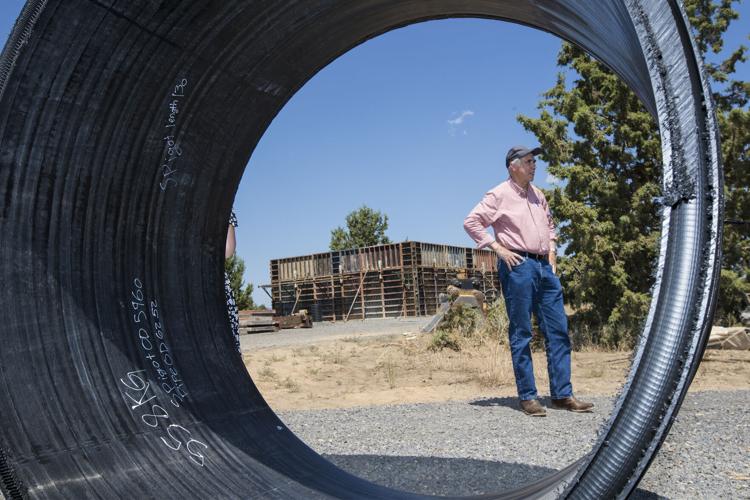This article was published on: 08/14/22 12:13 PM
Hundreds of miles of canals fill with water for delivery to farmers across Central Oregon every summer.
The Deschutes Basin’s eight irrigation districts, which deliver water from the basin’s rivers to its farmers through those canals, have a key role to play in water conservation. A significant share — up to 50% in some cases, according to the Deschutes River Conservancy — of the water which moves through some districts’ centuries old canals never makes it to farms, evaporating or seeping into the region’s porous, volcanic soil below.
Replacing those antiquated canals with pipes could save those loses and return over 100,000 acre-feet of water to the river, a 2019 study found.
(An acre-foot is the amount it takes to cover an acre of land with a foot of water.)
The Arnold, Central Oregon, and North Unit Irrigation Districts are all planning for the modernization of their systems. Work is also underway in the Ochoco, Swalley and Tumalo Irrigation Districts.
A federal officials hailed the Three Sisters Irrigation District earlier this month for nearing the completion of its modernization. The district has piped 62 of its 65 miles of canals and built three hydropower facilities along the way, which district officials said save upwards of 55 cubic feet per second of water and millions of kilowatt hours of electricity a year.
Still, canal piping efforts are massive undertakings, requiring irrigation districts to spend tens of millions of dollars, often with federal assistance. The same study that found canal piping could save the most water of any of the options available to managers also found it would be the most expensive — up to $6,000 per acre-foot of water saved, compared to just several hundred per acre-foot saved by implementing market-based approaches like water leasing and transfer programs.
That’s a major reason some systems have become so antiquated, according to Julie O’Shea, executive director of the Hood River-based Farmer’s Conservation Alliance.
“When you think about these 100-year-old systems, someone’s out there everyday trying to make it work,” O’Shea told The Bulletin. “It’s so much work and that’s why the system is 100 years old.”
But canal piping can still have an impact on well water users some distance away. That’s because of the region’s porous soil: The same volcanic soil that allows water to seep out of canals also allows it to seep into the region’s aquifer, where it’s pumped out through wells or pushed out into natural springs to the north, providing cool water for fish in the streams.
Piping canals does block some of that water from seeping into the aquifer. Canal lining made up for between 5% and 10% of well level declines between 1997 and 2008, according to a U.S. Geological Survey study. Still, climate change and reductions in precipitation made up for a much greater share of well declines, between 60% and 80%, while well pumping made up for the rest.
“I think it’s really important to understand everybody wants a stable aquifer, but to understand that a portion of that aquifer is part of artificially returned by those canals is a really important point,” said Kate Fitzpatrick, executive director of the Deschutes River Conservancy. “You actually may want to anticipate some decline in that aquifer because you’re restoring a river.”
Though the aquifer makes up a large share of the basin’s water, it isn’t shown as part of some analyses of the basin’s available water. The relationship between groundwater and surface water in the Deschutes Basin is a critical piece of the puzzle for understanding the future of water in the basin, especially as more wells continue to dry up and controversy swirls around proposed development, Fitzpatrick said.
That relationship will also be a central issue as the state decides what to do with the Deschutes Groundwater Mitigation Program, set to expire in 2029.
Simply put, the program requires that anyone who pumps water out of the ground in the basin, other than for certain exempt uses like domestic and noncommercial irrigation, puts water back into the river’s surface water. The program, authorized by the Oregon Legislature and set to sunset in 2029, is the only one of its kind in the state, and an attempt at reconciling present-day needs with a century-old system designed for encouraging settlement.
“The citizens’ mindset (in the early 1900s) was quite different than it is today,” said Kyle Gorman, region manager for the Oregon Water Resources Department. “It was more about we have to survive, so we need to put water on the land. That kind of changed as we’ve reached modern times, where recreation and fish and wildlife uses play a much larger role in what we do to the streams.”
Still, it isn’t perfect. Experts in the region are already discussing what kinds of changes might be necessary in the program’s next iteration, from a cap the program sets on how much water can be pumped, to the use of agricultural water rights for mitigation, to the quality of water that must be returned to streams and whether it’s suitable for the species who rely on it.
-Zack Demars




